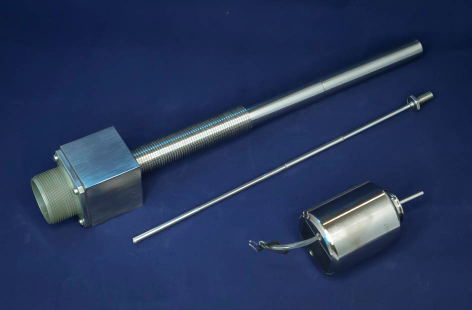How LVDTs and RVDTs Help Commercial Planes Fly
If you have ever traveled by plane, you can feel the massive vibrations required for an aircraft to operate -- especially when the aircraft hits turbulence. The components of the plane, individually and together, must withstand all harsh vibrations aircraft endure. Sentech’s Aerospace Linear Variable Differential Transformers (LVDT) and Rotary Variable Differential Transformers (RVDT) are designed to help commercial aircrafts fly safely by providing precise, state-of-the-art, and frictionless feedback to ensure flight controls and mechanism positions are working properly.
LVDTs

LVDT's are required where high reliability and harsh environmental applications prevail. LVDTs work under the principle of mutual induction and displacement, where non-electrical energy is converted into electrical energy. The energy gets converted to a reliable solution for a precise linear displacement (position) and gauging measurement.
The LVDT consists of three solenoidal coils. The primary core is wound on the tube then two secondary coils are layer wound on top of the primary on the tube. As the core moves, it links to two secondary coils causing the induced voltages to change. These coils are connected so that the output voltage is the differential between the two secondary voltages
Because the sliding core doesn’t touch the inside of the tube, it moves without friction, making the aerospace LVDT a highly reliable device and ideal for aviation use. LVDTs in aerospace offer an absence of sliding or rotating contacts allows it to be completely sealed against the harsh vibrations created during takeoff, landing, and turbulence.
LVDT and RVDT
LVDTs and RVDTs measure the position of multiple instruments used in pilot controls, on-engine feedback, and control surface position applications. The RVDT is a rotary variable differential transformer that measures angular displacement, producing an AC output with direct comparability to the angular movement. The LVDT is a linear variable differential transformer that converts an object’s rectilinear motion into electrical signals.
Both the LVDT sensor and the RVDT consists of a primary coil and two secondary coils. The main difference is the RVDT works through mutual induction, providing a steady supply of AC flow to the primary winding. The resulting magnetic field induces electrical signals in the secondary coils according to the shaft position. Sentech offers AC or DC units in conformance with long-term life requirements.
The LVDT is a rectangular shape and the RVDT cam-shaped. LVDTs convert linear motion into an electric signal, whereas the RVDT calculates an object’s angular motion. The LVDT works at a voltage input of between 1-24 Volts RMS, and the RVDT operates at an input voltage of up to 3 Volts RMS. The LVDT has a measurement range of ±100μm to ±25cm, while the RVDT measurement range is up to a maximum of ±40ᵒ.
LVDT and RVDT sensors are the preferred choices for commercial aircraft as both types of sensors offer a wide range of measurements and use low power. Both are highly sensitive and not easily impacted by hysteresis. The LVDT and RVDT in aviation are relatively low-cost devices, and their compact size makes them easy to install and handle.
LVDT Sensor
LVDTs are used as a position sensor in the feedback mechanism of a fly by wire system in commercial aircraft and measure the extent to which a control surface has been deflected as it is a linear motion. The fly-by-wire system is the control command which informs the rolling, yawing, pitching generated by the pilot and is recognized by the flight computer. The signal from the LVDT is fed into the feedback system, where the pilot can then view this feedback data.
Due to both LVDT and RVDT sensors’ frictionless operation, there is a minimal chance of losing functional integrity in an aircraft due to normal wear and tear. Due to their reliability, LVDTs and RVDTs in aircrafts are a top choice for engineers looking for sensors.
LVDT in Aerospace

Contactless LVDT sensors are chosen for use in commercial aircraft due to their long operational life and high reliability in extreme operating conditions. Virtually all fly-by-wire systems have built-in redundancy, they can use either multiple single channel sensors or one multi-channel sensors.
LVDTs and RVDTs play an essential role in modern aviation as these sensors measure various parameters like control, navigation, and monitoring of electronic systems. These Avionic systems include commercial aircraft systems used for navigation and display, communication, searchlights, and other complex tactical systems and early warning signals.
Key Takeaways:
- LVDTs and RVDT are contactless sensors used to help planes fly.
- LVDT and RVDT are both low-cost devices.
- Their compact size makes them easy to install and handle, and they operate seamlessly in harsh conditions.
- They are extremely reliable for commercial planes and aerospace applications.
Sentech offers superior repeatability of its LVDT’s and RVDT’s, ensuring consistent and accurate measurements over a long period of its operational life. Contact us today as we are confident that with 30 years in the industry, we will find a solution for your specific needs.


